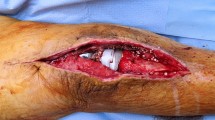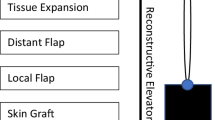Abstract
Purpose
Total knee arthroplasty revision has wound healing deficits of up to 20 %. Defects in the knee region of multimorbid patients are hard to treat as complete explantation and revision arthroplasty is often too burdensome for them. In this study, we present our results with flaps for the treatment of defects after knee replacement, arthrodesis or osteosynthesis.
Methods
Twenty-five patients (26 knees) with defects in the knee region were treated with flaps. Mean follow-up was 37 months (13–61) and the patients had a mean age of 72 years (49–85). A total of 39 flaps were performed (27 muscle flaps, seven fascio-cutaneous flaps and five free flaps).
Results
Patients with more than three comorbidities showed higher risk of complications after surgery. Fifteen patients showed no infection at last follow up. Five patients received an arthrodesis of the knee, two showed persistent infection of the implant with fistula, and three were amputated above the knee.
Conclusions
Amputation could be avoided in 22 cases (85 %). The gastrocnemius muscle flap showed good results in the treatment of defects after arthroplasty or arthrodesis of the knee in multimorbid patients. This procedure can be used if further revision surgery is not indicated.




Similar content being viewed by others
References
Galat DD, McGovern SC, Larson DR, Harrington JR, Hanssen AD, Clarke HD (2009) Surgical treatment of early wound complications following primary total knee arthroplasty. J Bone Joint Surg Am 91:48–54. doi:10.2106/JBJS.G.01371
Kubista B, Hartzler RU, Wood CM, Osmon DR, Hanssen AD, Lewallen DG (2012) Reinfection after two-stage revision for periprosthetic infection of total knee arthroplasty. Int Orthop 36:65–71. doi:10.1007/s00264-011-1267-x
Peersman G, Laskin R, Davis J, Peterson M (2001) Infection in total knee replacement: a retrospective review of 6489 total knee replacements. Clin Orthop Relat Res 392:15–23
Minnema B, Vearncombe M, Augustin A, Gollish J, Simor AE (2004) Risk factors for surgical-site infection following primary total knee arthroplasty. Infect Control Hosp Epidemiol 25:477–480. doi:10.1086/502425
England SP, Stern SH, Insall JN, Windsor RE (1990) Total knee arthroplasty in diabetes mellitus. Clin Orthop Relat Res 260:130–134
Moller AM, Pedersen T, Villebro N, Munksgaard A (2003) Effect of smoking on early complications after elective orthopaedic surgery. J Bone Joint Surg (Br) 85:178–181
Luque R, Rizo B, Urda A, Garcia-Crespo R, Moro E, Marco F, Lopez-Duran L (2014) Predictive factors for failure after total knee replacement revision. Int Orthop 38:429–435. doi:10.1007/s00264-013-2268-8
Johnson DP (1988) Midline or parapatellar incision for knee arthroplasty. A comparative study of wound viability. J Bone Joint Surg (Br) 70:656–658
Peersman G, Laskin R, Davis J, Peterson MG, Richart T (2006) Prolonged operative time correlates with increased infection rate after total knee arthroplasty. HSS J 2:70–72. doi:10.1007/s11420-005-0130-2
Del Pozo JL, Patel R (2009) Clinical practice. Infection associated with prosthetic joints. N Engl J Med 361:787–794. doi:10.1056/NEJMcp0905029
Clarke MT, Longstaff L, Edwards D, Rushton N (2001) Tourniquet-induced wound hypoxia after total knee replacement. J Bone Joint Surg (Br) 83:40–44
Saleh K, Olson M, Resig S, Bershadsky B, Kuskowski M, Gioe T, Robinson H, Schmidt R, McElfresh E (2002) Predictors of wound infection in hip and knee joint replacement: results from a 20 year surveillance program. J Orthop Res 20:506–515. doi:10.1016/S0736-0266(01)00153-X
Gaine WJ, Ramamohan NA, Hussein NA, Hullin MG, McCreath SW (2000) Wound infection in hip and knee arthroplasty. J Bone Joint Surg (Br) 82:561–565
Ovadia D, Luger E, Bickels J, Menachem A, Dekel S (1997) Efficacy of closed wound drainage after total joint arthroplasty. A prospective randomized study. J Arthroplasty 12:317–321
Drinkwater CJ, Neil MJ (1995) Optimal timing of wound drain removal following total joint arthroplasty. J Arthroplasty 10:185–189
Jamsen E, Huhtala H, Puolakka T, Moilanen T (2009) Risk factors for infection after knee arthroplasty. A register-based analysis of 43,149 cases. J Bone Joint Surg Am 91:38–47. doi:10.2106/JBJS.G.01686
Patel VP, Walsh M, Sehgal B, Preston C, DeWal H, Di Cesare PE (2007) Factors associated with prolonged wound drainage after primary total hip and knee arthroplasty. J Bone Joint Surg Am 89:33–38. doi:10.2106/JBJS.F.00163
Garvin KL, Konigsberg BS (2011) Infection following total knee arthroplasty: prevention and management. J Bone Joint Surg Am 93:1167–1175
Gerwin M, Rothaus KO, Windsor RE, Brause BD, Insall JN (1993) Gastrocnemius muscle flap coverage of exposed or infected knee prostheses. Clin Orthop Relat Res 286:64–70
Jenny JY, Barbe B, Gaudias J, Boeri C, Argenson JN (2013) High infection control rate and function after routine One-stage exchange for chronically infected TKA. Clin Orthop Relat Res 471:238–243. doi:10.1007/s11999-012-2480-7
Suda AJ, Heppert V (2010) Vastus lateralis muscle flap for infected hips after resection arthroplasty. J Bone Joint Surg (Br) 92:1654–1658. doi:10.1302/0301-620x.92b12.25212
Zimmerli W, Trampuz A, Ochsner PE (2004) Prosthetic-joint infections. N Engl J Med 351:1645–1654. doi:10.1056/NEJMra040181
Conway JD, Mont MA, Bezwada HP (2004) Arthrodesis of the knee. J Bone Joint Surg Am 86-A:835–848
Harris IE, Leff AR, Gitelis S, Simon MA (1990) Function after amputation, arthrodesis, or arthroplasty for tumors about the knee. J Bone Joint Surg Am 72:1477–1485
Browne EZ Jr, Stulberg BN, Sood R (1994) The use of muscle flaps for salvage of failed total knee arthroplasty. Br J Plast Surg 47:42–45
Laing JH, Hancock K, Harrison DH (1992) The exposed total knee replacement prosthesis: a new classification and treatment algorithm. Br J Plast Surg 45:66–69
Ries MD (2002) Skin necrosis after total knee arthroplasty. J Arthroplasty 17:74–77
Menderes A, Demirdover C, Yilmaz M, Vayvada H, Barutcu A (2002) Reconstruction of soft tissue defects following total knee arthroplasty. Knee 9:215–219
Nahabedian MY, Orlando JC, Delanois RE, Mont MA, Hungerford DS (1998) Salvage procedures for complex soft tissue defects of the knee. Clin Orthop Relat Res 356:119–124
Cetrulo CL Jr, Shiba T, Friel MT, Davis B, Buntic RF, Buncke GM, Brooks D (2008) Management of exposed total knee prostheses with microvascular tissue transfer. Microsurgery 28:617–622. doi:10.1002/micr.20578
Adam RF, Watson SB, Jarratt JW, Noble J, Watson JS (1994) Outcome after flap cover for exposed total knee arthroplasties. A report of 25 cases. J Bone Joint Surg (Br) 76:750–753
Panni AS, Vasso M, Cerciello S, Salgarello M (2011) Wound complications in total knee arthroplasty. Which flap is to be used? With or without retention of prosthesis? Knee Surg Sports Traumatol Arthrosc 19:1060–1068. doi:10.1007/s00167-010-1328-5
Nahabedian MY, Mont MA, Orlando JC, Delanois RE, Hungerford DS (1999) Operative management and outcome of complex wounds following total knee arthroplasty. Plast Reconstr Surg 104:1688–1697
Chandrasekhar B, Brien W (1993) Coverage strategies in total joint replacement. Orthop Clin N Am 24:523–529
Beausang ES, Ang EE, Lipa JE, Irish JC, Brown DH, Gullane PJ, Neligan PC (2003) Microvascular free tissue transfer in elderly patients: the Toronto experience. Head Neck 25:549–553. doi:10.1002/hed.10240
Author information
Authors and Affiliations
Corresponding author
Rights and permissions
About this article
Cite this article
Suda, A.J., Cieslik, A., Grützner, P.A. et al. Flaps for closure of soft tissue defects in infected revision knee arthroplasty. International Orthopaedics (SICOT) 38, 1387–1392 (2014). https://doi.org/10.1007/s00264-014-2316-z
Received:
Accepted:
Published:
Issue Date:
DOI: https://doi.org/10.1007/s00264-014-2316-z




